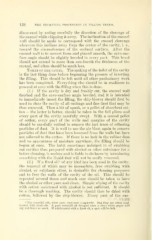Page 286 - My FlipBook
P. 286
128 THE TECHNICAL PROCEDURES IN FILLING TEETH.
discovered by noting carefully the direction of the cleavage of
the enamel while chipping it away. The inclination of the enamel
wall should be made to correspond with the enamel cleavage
wherever this inclines away from the center of the cavity, i. e.,
toward the circumference of the occlusal surface. After the
enamel wall is in correct form and planed smooth, the cavo-sur-
face angle should be slightly beveled in every part. This bevel
should not extend to more than one-fourth the thickness of the
enamel, and often should be much less.
Toilet of the cavity. The maldng of the toilet of the cavity
is the last thing done before beginning the process of inserting
the filling. This should be left until all other preliminary work
has been completed. Everything else should be in readiness to
proceed at once with the filling when this is done.
(1.) If the cavity is dry and freshly cut, the enamel wall
finished and the cavo-surface angle beveled, and it is intended
to immediately insert the filling, the chip-blower should first be
used to clear the cavity of all cuttings and fine dust that may be
thus removed. Then a bit of spunk, or a pellet of absorbent cot-
ton — the latter is better, should be taken in the foil pliers and
every part of the cavity carefully swept. With a second pellet
of cotton, every part of the walls and margins of the cavity
should be carefully rubbed to remove the last trace of adhering
particles of dust. It is well to use the air blast again to remove
particles of dust that have been loosened from the walls but have
not adhered to the cotton. If there is no leak in the rubber dam
and no a^Dpearance of moisture anywhere, the filling should be
begun at once. The habit sometimes indulged in of swabbing
out cavities thus prepared with alcohol or other substance for a
better cleaning, is useless and is liable to do harm by introducing
something with the liquid that will not be easily removed.
(2.) If a fixed oil* of any kind has been used in the cavity,
the removal of which may bo incomplete, free swabbing with
alcohol, or sulphuric ether, is desirable for cleaning purposes
and to free the walls of the cavity of the oil. This should be
repeated several times and much care should be taken to have
the alcohol or ether pure and clean. Simple wiping of the cavity
with cotton moistened with alcohol is not sufficient. It should
be a thorough washing. The cavity should then be dried with
cotton, followed by the chip-blower. Every part of the sur-
• The essential oils, when pure, evaporate completely. But they are often adul-
terated with fixed oils. A pure essential oil dropped upon a clean white paper will
dry and leave no mark. If adulterated with a fixed oil, a spot will bo loft.


